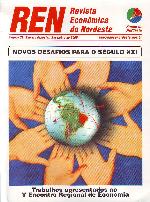ENDOGENEIDADE VERSUS EXOGENEIDADE DO CRESCIMENTO ECONÔMICO: UMA ANÁLISE COMPARATIVA ENTRE NORDESTE, BRASIL E PAÍSES SELECIONADOS
DOI:
https://doi.org/10.61673/ren.2000.1925Keywords:
Endogenous Economic Growth, Exogenous Economic Growth, ForecastingAbstract
Comparing the long run growth path among Northeast Brazil, Brazil, Latin American countries and the seven most developed countries, is the main focus of this paper. Exogenous growth models and endogenous growth models provide the theoretical background. The paper addresses to two concerns in order to: a) Determine whether the growth path of developing economies is explained by endogenous or exogenous growth theory hypotheses, and compare it with the endogenous growth of the developed economies; b) Simulate a growth rate for the developing and selected developed countries, in case they had the same rate of growth of the explanatory variables (human capital, infrastructure capital, income inequality, trade liberation, size of financial sector, government expenditure) observed for the US. To attain the objectives, data for the period 1950-1992 were applied to suitable econometric models – polynomial distributed lag, simultaneous equations – where estimates from least squares and panel data and hypothesis testing showed with confidence and accuracy that: 1) Endogenous growt hypothesis for Northeast can not be rejected; 2) In all economies, accurate simulations have proved that human capital and consequently technological improvement in the economy as an engine of growth are the responsible factors to generate increasing (...)








